Growing Wax Apple:
Syzygium samarangense
Back to Fruit, Berries and Nuts
Botanical Overview
Belonging to the Myrtle family (Myrtaceae), the Syzygium genus contains 1139 species, the most famous being Syzygium aromaticum, Cloves. Syzygium samarangense, Wax Apple, has become widely cultivated in the tropics. More than 100 cultivars have been developed.
Description
Form:
A large bushy shrub that becomes a tree.
Lifespan:
40-400 years.
Leaf retention:
Evergreen to cold-deciduous. This tree may lose one-third of its leaves in a cold winter.
Growth rate:
Rapid.
Mature Size:
15-40' (4.5-12m) high.
Flowers:
Four small, whitish petals are overwhelmed by numerous, much longer, yellow-white stamens.
They are clustered, fragrant, and fall to the ground after 2-3 days.
Bloom:
Spring. This tree may bloom 2-5 times a year in its native environment, but inconsistently
from one year to the next. In Asia, farmers may flood the soil to induce blooming.
It has better bloom and fruit set in hot, dry weather.
Self-fruitful:
This tree is self pollinating.
Years before fruiting:
3-5.
Fruit:
Bell-shaped when mature, with thin, waxy skin, an indented bottom covered by four fleshy,
calyx nodes, and rather light in weight. The flesh is white, with a spongy center and a more
dense, juicy outer layer. It has an aromatic, slightly sweet to tart taste depending on the
cultivar. Some cultivars have a rose water flavor. There may be two 1/4" (0.635cm) wide seeds
in the center, but usually none. The flesh of some cultivars is lightly crisp, of others,
juicy like a watermelon.
Months for fruit to ripen:
6-7 weeks. The fruit are ripe when fully colored and the skin develops a shiny, waxy
appearance. A single 5 year old tree may produce 700 fruit.
Storage after harvest:
The fruit are normally eaten within two days of harvest because their thin skin rapidly loses
moisture. Commercially in Asia, they are individually sealed in plastic film immediately after
harvest, carefully packed, and shipped to market for sale the following day.
Leaves:
Green, elliptic to oblong, fragrant when bruised. This tree provides dense shade.
Stems:
No thorns.
Roots:
Not invasive.
Cultivars of Note:
'Green Giant' grown in Malaysia. The fruit have 2-3
times more seeds than the 'Pink' and 'Red' cultivars and skin with a rough, green surface
at maturity. This tree has a wide canopy.
'Pink' grown in Malaysia and Taiwan.
The pink to red fruit are shorter than the 'Green' and 'Red' cultivars. This tree
produces the most fruit.
'Red' grown in Malaysia. The dark red fruit are
longer than the 'Green' and 'Pink' cultivars.
'Black Pearl' / 'Black Diamond' grown in China.
Somewhat darker, red-brown or purple-red fruit. The names reflect a difference in growing
location and a resulting difference in size and juiciness.
'Big Fruit' grown in Taiwan. Red fruit.
'Vietnam White' grown in Vietnam and Taiwan.
White skinned fruit.
Wildlife:
The flowers attract bees. The fruit attract birds and mammals and should be bagged to prevent
predation when they start to develop color.
Toxic / Danger:
No.
Origin:
Malaysia. Its native range is now considered to encompass India to Indonesia.
Cultivation and Uses
USDA hardiness zones:
10-11. This tree must be protected from freezing when young. After 3-5 years, it may handle
28°F (-2.2°C) for a brief period.
Chill hours:
None.
Heat tolerant:
This tree needs afternoon shade and extra water over 90°F (32°C).
Drought tolerant:
Not in hot, dry climates.
Sun:
Full morning sun with deciduous afternoon shade.
Planting:
Locate this plant in an area that has full sun in winter and is not in a low spot where cold
air collects. It needs deciduous afternoon shade in high temperatures.
Planting on a slope or on top of a mound provides better drainage and helps flush salt out of the soil.
Plant after the last frost date, from mid winter to mid spring. Avoid planting during high summer temperatures or within two months of expected freezing temperatures.
Planting on a slope or on top of a mound provides better drainage and helps flush salt out of the soil.
Plant after the last frost date, from mid winter to mid spring. Avoid planting during high summer temperatures or within two months of expected freezing temperatures.
Soil:
Deep, high organic content, well draining. The tree does best in pH 5.6-6.5 (acidic to slightly
acidic) soil. Soil low in fertility will produce poor quality fruit. This plant is somewhat
salt sensitive and a saline environment can reduce fruit size.
Fertilize:
Apply organic fertilizer after harvest. In alkaline soil apply plant micronutrients once a
month to irrigation water.
Water after becoming established:
A reliable water supply, such as a nearby pond is best.
Deep water once or twice a week in warm weather. This tree can be flood or basin irrigated.
Mulch:
Apply organic mulch inside the drip line and 8" (21cm) away from the trunk to reduce moisture
loss.
First Three Years Care:
Protect from freezing.
Prune:
Trim to desired height and shape mid winter. Excess marble-sized fruit may have to be thinned
to one every 4-6" (10-15cm) to avoid branch breakage.
Litter:
Spent flowers. Partial leaf loss in cold weather.
Propagation:
Layering, leaf buds of a desirable cultivar grafted onto its own species or onto a Wild Rose
Apple (Syzygium pycnanthum, formerly S. densiflorum) seedling. Cuttings root easily in a glass
of water kept in indirect sunlight. Fresh seed sprout easily, but do not breed true. Dried
seed are not viable.
Uses:
The edible fruit are eaten raw, sometimes with salt or sugar, or diced for salads. Greenish
colored fruit may be cooked into a sauce. Wax Apple is not considered suitable for jams or
jellies. Immature fruit are pickled in some countries.
This tree is useful as a windbreak because of its dense foliage.
This tree is useful as a windbreak because of its dense foliage.
Comments
This plant is also known as Java Apple, but it does not resemble an apple in texture, flavor,
or appearance. Other names are Rose Apple, which really describes some cultivars more
than others, Wax Jambu, and rarely, Bell Fruit. It is not to be confused with Water Apple nor
Malay apple which are different species.
Do you have additional information or a different experience for these plants that you would like to share? Email info@GardenOracle.com. All contributions are welcome and appreciated.
Do you have additional information or a different experience for these plants that you would like to share? Email info@GardenOracle.com. All contributions are welcome and appreciated.




Latest update: August, 2024
© 2008-2025 by GardenOracle.com

